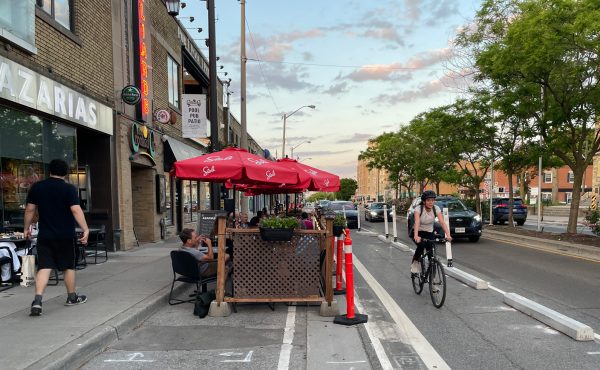Editor’s note: This is the second post in a series that investigates the emerging concept of the Naturally Occurring Cultural District (NOCD). Posts will explore the ways in which the NOCD concept could be applied to specific areas in Toronto to inform more equitable, localized forms of cultural planning.
![]()
Toronto teems with art, life, community, and culture. With such an incredible diversity of cultural activities occurring in the city each day, how can municipal planning efforts support and sustain these activities?
The first post in this series explored the emerging concept of Naturally Occurring Cultural Districts (NOCDs), urban areas that develop organically to support clusters of unique cultural facilities and organizations. The concept is gaining traction in the United States and has been applied to a number of neighbourhoods in New York City, inspiring creative policy and planning solutions to support local cultural activities.
Beyond New York, there has been growing recognition amongst planners, policy-makers, and arts advocates of the power of the NOCD concept to support small-scale, community-based arts organizations, which have been shown to improve public access to the arts and to foster sustainable community and economic development.
Demonstrating support for existing cultural assets by incorporating the NOCD concept into municipal planning efforts has the potential sustain a strong local cultural identity. However, the overwhelming tendency of the past two decades of cultural planning has been to invest in large-scale, tourism-oriented cultural facilities and programs that attract visitors and investment and position the city as a cultural center. In this context, small-scale, community-based arts activities — the milieu of exiting theaters, performance spaces, incubators, galleries, and workshops — have experienced difficulty in maintaining operations with low funding and support. With local culture recognized as a critical city-building force, it is imperative that these local cultural activities are actively supported through municipal planning efforts.
Since the early 2000’s, the City of Toronto, like many other large North American cities, has explicitly focused on the role of culture in fostering economic development. The Culture Plan for the Creative City, a 2003 document produced by the City of Toronto’s Culture Division, highlighted the potential of the city’s arts, culture, and heritage to attract the mobile, creative class to Toronto and to strengthen the cultural economy. A series of cultural mapping reports, examining patterns in the location of cultural facilities, artist residences, and creative industry workspaces, were produced to highlight potential areas of focus for funding and development.
The NOCD concept has not been officially recognized in Toronto’s cultural planning rhetoric. However, the City’s use of mapping techniques to track cultural clusters demonstrates a parallel focus on the impact that hubs of creative industries, artists, and cultural facilities have on local economies, social well-being, neighbourhood character, and quality of life. The 2011 report titled From the Ground Up: Growing Toronto’s Cultural Sector employs a Cultural Location Index to identify the neighbourhoods in which the highest percentages of cultural workers reside and work. This focus on the Cultural Location Index demonstrates an acute awareness of the importance of naturally occurring cultural work and residence clusters, both of which are central to the NOCD concept.
Based on this Cultural Location Index data, From the Ground Up highlights the “Downtown Cultural Work District” as a unique creative cluster in the city. The District, which covers an area slightly larger than the Entertainment District, is considered a “highly developed cultural economy” in which over 8,000 cultural workers in a range of occupations including art, fashion, broadcasting, publishing, and design, are employed. More than 125 commercial, non-profit, and community businesses, such as CityTV, 401 Richmond, Arts&Crafts Productions, and The Globe and Mail, are located in the District. Large-scale, high profile cultural facilities such as CBC Radio and Roy Thomson Hall serve as anchors to the multitude of smaller scale, independent arts organizations and workspaces. This range of cultural functions in close proximity is believed to foster collaboration and build cultural capital. Furthermore, the area’s diversity with respect to commerce, markets, and worker skills, has supported a sustainable, adaptable, and growing economy that not only attracts visitors, but also new businesses.
Acknowledging the Downtown Cultural Work District’s robust economy, it’s diversity of cultural assets and functions, and it’s history of growth and resilience, From the Ground Up has recommended that the District be formally recognized as the heart of the city’s cultural sector. By recognizing the centrality of the area to Toronto’s cultural economy, the City is demonstrating support for the unique assemblage of small-scale, community-based, and showcase cultural activities and organizations that exist in the area.
The application of cultural district designation, in this case, recognizes the value of the organic history of this cultural cluster and its responsiveness to community needs and desires. Treating the Downtown Cultural Work District as an NOCD may help to shift Toronto’s planning and policy focus away from imposing cultural district designation and towards discovering existing assets.
Evidence of the City’s support for the Downtown Cultural Work District is encouraging. By recognizing how the area’s delicate balance of diversity has allowed both small- and large-scale cultural facilities to thrive as a local NOCD, the City’s policy makers may be better equipped to respond with solutions that support and sustain the unique character of the area as well as the numerous art spaces that exist within.
Photo by hao$. Map from From the Ground Up: Growing Toronto’s Cultural Sector.





